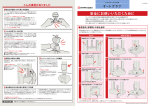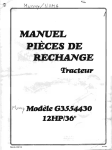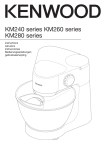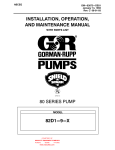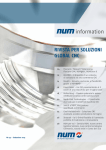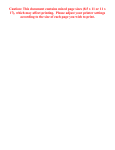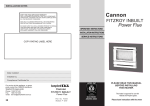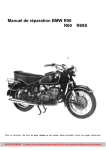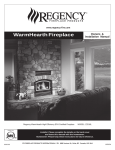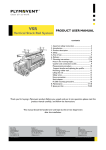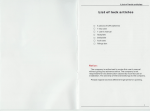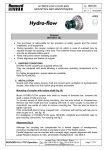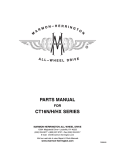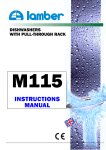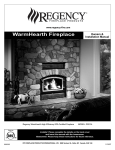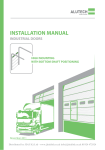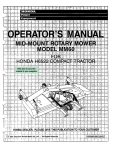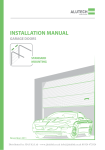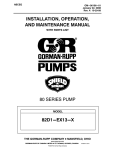Download MT-14/MT-17 - Marmon-Herrington Aftermarket
Transcript
REPAIR MANUAL DRIVEN FRONT AXLE MT14/MT17 SERIES MARMON-HERRINGTON ALL-WHEEL DRIVE 13001 Magisterial Drive • Louisville, KY 40223 (502) 253-0277 • (800) 227-0727 • Fax (502) 253-0317 E-mail: [email protected] 1 SECTION 202 SECTION CONTENTS SECTION NO. PAGE FORWORD...........................................................................................................................203 5 DRAWING OF THE DRIVEN FRONT AXLES TYPE MH MT14/MT17................................204 6 TECHNICAL DATA..............................................................................................................205 9 TORQUE RATINGS.............................................................................................................206 13 ADJUSTMENT DATA...........................................................................................................207 15 GENERAL SERVICE INSTRUCTIONS...............................................................................209 16 WHEEL DRIVE; WHEEL HUB..................................................................................... 16 KNUCKLE HOUSING.................................................................................................. 16 WHEEL BRAKE........................................................................................................... 16 DIFFERENTIAL CARRIER HEAD............................................................................... 16 GENERAL INSTRUCTIONS........................................................................................ 16 WHEEL DRIVE, WHEEL HUB WHEEL DRIVE, WHEEL HUB SECTIONAL VIEW.....................................................210 17 PARTS OF THE WHEEL DRIVE, WHEEL HUB..........................................................211 18 REMOVING AND REINSTALLING THE WHEEL DISK..............................................212 19 REMOVING AND REINSTALLING THE BRAKE DRUM............................................213 19 REMOVING AND REINSTALLING THE END-COVER...............................................214 19 REMOVING AND REINSTALLING THE PINION CARRIER, ADJUSTING THE AXLE-SHAFT CLEARANCE.......................................220 19 DISASSEMBLING AND REASSEMBLING THE PLANETARY GEAR.......................221 20 REMOVING AND REINSTALLING THE SUN GEAR..................................................222 20 REMOVING AND REINSTALLING THE WHEEL HUB...............................................223 21 ADJUSTMENT OF AXIAL PLAY.................................................................................224 21 DISASSEMBLING AND REASSEMBLING THE RING GEAR SUPPORT.................225 23 INSTALLATION INSTRUCTIONS FOR PARTS OF ANTI-LOCKING SYSTEM.........229 24 2 SECTION SECTION NO. PAGE REMOVING AND REINSTALLING THE TIE-ROD, ADJUSTING THE TOE-IN AND THE WHEEL TURN ANGLES..............................241 25 REPAIRING TIE ROD..................................................................................................242 26 DISASSEMBLING AND REASSEMBLING THE KNUCKLE HOUSING AND THE SPINDLE..................................................................................................243 27 DISASSEMBLING AND REASSEMBLING THE DOUBLE-JOINT AND THE KNUCKLE SUPPORT.............................................................................244 27 REMOVING AND REINSTALLING ADJUSTING, THE STEER ARMS, THE BRAKE CHAMBER HOLDER AND THE TIE-ROD ARMS.............................245 28 ASSEMBLING THE DOUBLE-JOINT (REPLACING THE AXLE-SHAFT).................246 29 REMOVING AND REINSTALLING THE INNER BEARING AND FASTENERS OF THE SPINDLE TRUNNION.................................................247 31 FRONT AXLE HOUSING FRONT WHEEL BRAKE DRAWING OF THE FRONT WHEEL BRAKE.............................................................260 33 PARTS OF THE FRONT WHEEL BRAKE..................................................................261 33 REMOVING AND REINSTALLING THE BRAKE SHOES..........................................262 34 REPAIRING THE BRAKE SHOES AND THE BRAKE DRUM....................................263 34 REMOVING AND REINSTALLING THE BRAKE BRACKET, ASSEMBLING THE SPRING SUPPORTING PIN...................................................264 36 REMOVING AND INSTALLATION OF THE BRAKE LEVER AND THE CAMSHAFT.............................................................................................265 37 REPAIRING THE CAMSHAFT BEARING SUPPORT.................................................266 37 MANUAL SLACK ADJUSTER AND ITS ASSEMBLING............................................267 39 AUTOMATIC SLACK ADJUSTER...............................................................................268 39 DIFFERENTIAL CARRIER ASSEMBLY DIFFERENTIAL CARRIER ASSEMBLY DIFFERENTIAL SECTIONAL VIEW...................................................................................................310 41 PARTS OF THE DIFFERENTIAL CARRIER ASSEMBLY...........................................311 43 REMOVING AND REINSTALLING THE DIFFERENTIAL CARRIER ASSEMBLY.............................................................................................312 43 REMOVING AND REINSTALLING THE COMPANION FLANGE AND THE COVER....................................................................................................313 43 REMOVING AND REINSTALLING THE DIFFERENTIAL, ADJUSTING THE BACKLASH AND THE CONTACT PATTERN...........................314 45 3 SECTION SECTION NO. PAGE DISASSEMBLING AND REASSEMBLING THE DIFFERENTIAL..............................315 47 DISASSEMBLING AND REASSEMBLING THE BEARING CAGE, ADJUSTING THE CENTER DISTANCE..................................................................316 49 DISASSEMBLING AND REASSEMBLING THE BEARING CAGE............................317 50 OIL FILL-UP, RUN, CHECK.................................................................................................395 53 4 SECTION 203 FOREWORD This publication “GENERAL REPAIR INSTRUCTIONS” was prepared for workshops and contains all the necessary assembly instructions as well as data to be checked and adjusted during repair, with the knowledge of which repair and adjustment of the MARMON-HERRINGTON MT14/MT17 type driven front axles. For technical data on the specific type versions of the M-H MT14/MT17 type driven front axles refer to the publication “TECHNICAL DATA”, while for the spare parts of that “PARTS CATALOG” grouped according to the Type. The “GENERAL REPAIR INSTRUCTIONS” contain sections divided into the technical data and the service instructions of the axle. The sections of the service instructions contain the disassembly and reassembly operations of the individual assembly unit, stating the special tools to be used. The serial numbers of the figures are started from the beginning in each section. The item numbers of the figures for an assembly unit are referred to in each section dealing with the assembly procedures. The manufacturer shall not be liable for warranty claims on damages resulting from negligence of the general service practice required for normal service operations but not contained in this Manual. For replacing assembly units or individual parts use ONLY genuine M-H MT14/MT17 made products. RIGHTS FOR ALTERATIONS RESERVED! MARMON-HERRINGTON COMPANY 13001 MAGISTERIAL DRIVE LOUISVILLE, KY 40245 TEL.: 502-253-0277 FAX: 502-253-0317 5 SECTION 204 DRAWINGS OF AXLES 6 DRIVE PINION HAND OF SPIRAL HUB PILOTED WHEEL R (bal-right-links) DRIVE PINION HAND OF SPIRAL R (bal-right-links) BALL SEAT WHEEL 7 8 DRIVE PINION HAND OF SPIRAL DIFFERENTIAL LOCK SECTION 205 TECHNICAL DATA DESCRIPTION UNITS TYPE MT14/MT17 SYSTEM: The reduction of the driven and steered front axle is of two-stage design. The reduction is accomplished by a pinion and ring gear set in the carrier and by spur planetary gearing in the wheel hub. DIMENSIONS: WHEEL TRACK mm a./ Rubber tire 2035* 16.5 x 22.5* b./ Rolling radius mm 540 c./ Sinking depth mm 168.1* Max. Width mm 2480* For detailed technical data marked by asterisk (*) at the type versions required by one orderer refer to publication “TECHNICAL DATA” related to the type versions. 9 TECHNICAL DATA DESCRIPTION UNITS 205 TYPE MT14/MT17 RATIOS: Ring gear/pinion 27/22 - 29/13 * Planetary gear 64/26 + 1 = 3.461 Total ratio 4.248 - 7.720 * Differential lock * GENERAL DATA: Camber 1° Knuckle pin inclination 7° Inner wheel turn angle max. 40° Rated axle load kg 7200* Max. Input torque Nm 3750 - 7370* Max. Input speed 1/sec r.p.s. 50 kg 710 - 721 * Mass of axle without oil fill WHEEL HUB EXECUTION “A” Bolt centering, for installing mm wheel disk Flange diameter: 280 h 11 Wheel nut hex. distance: 30 “C” Hub centering, for installing mm wheel disk Flange diameter: 280, 8 -32 Wheel nut hex. distance: 32 “D” Hub centering, for installing mm wheel disk Flange diameter: 221 -0.290 Wheel nut hex. distance: 3/4” -16 Constructional elements of ABS can be mounted into axle * Impulse ring installed * 10 TECHNICAL DATA DESCRIPTION UNITS 205 TYPE MT14/MT17 WHEEL BRAKE System: The wheel brake is out of simplex system internally acting drum brake. Brake drum diameter mm 420 Max. trued-up brake drum diameter mm 423 Brake lining width mm 420x180 Brake shoe clearance (at adjustment) mm 0.3 - 0.6 mm 7 Min. Brake lining thickness measured at brake shoe center (marked by upper edge of recess on side of brake lining) SLACK ADJUSTER Slack adjuster installation radius, “C” Distance of slack adjuster bushing bore center from seating plane of the chamber bracket Automatic slack adjuster mm 165 mm 233 ANTI-FRICTION BEARINGS IN WHEEL HUB Outer: Taper Roller Bearing 30218 A MGM Inner: Taper Roller Bearing 32218 A MGM IN WHEEL HUB PLANETARY GEAR: Cylindric Roller Bearing K 30x42x30 MGM ON DRIVE PINION: Outer: Taper Roller Bearing 32312 B X7JU MGM Inner: Taper Roller Bearing 32314 B X7JU MGM ON DIFFERENTIAL: On Half Case: Taper Roller Bearing 30215 A MGM Taper Roller Bearing 32215 A MGM On Flanged Case Half: 11 TECHNICAL DATA DESCRIPTION UNITS 205 TYPE MT14/MT17 IN THE STEERING KNUCKLE CARRIER: Cylindric Roller Bearing RNU 2209 EC Taper Roller Bearing 31310 SKF IN THE SPINDLE: Cylindric Roller Bearing NKS 50 INA IN THE DOUBLE JOINT: Needle Roller Bearing Bushing Assy. GWB 6.369.37.006.00.020 SEALS: In Wheel Hub: 1HH1 145x175x17 NB STEFA SYSTEM 500 In Differential Carrier: AS 75x95x10 FP SIMMERWERKE In Camshaft Bushing Bracket 42x52x5 NB-AFIT In Spindle ASL 50x65x8-NB SIMMERWERKE In Steering Knuckle Carrier “O” Ring 012.0-3340-018 Oil Seal A49. 5x80x8-NB SIMMERWERKE 12 206 TORQUE RATINGS SECTION/FIGURE DESIGNATION ITEM No. TYPE MT14/MT17 NOTE: Nm to ftlb = Nm ÷ 1.3558 (Ex. 600 Nm ÷ 1.3558 = 443 ftlb) WHEEL HUB, AXLE HOUSING 210/1 Nm With lock washer Hex. distance 30 mm “A” 81 360 - 400 Sole nut Hex. distance 32 mm “C” 41 540 - 670 Wheel nuts Wheel nuts “D” - As specified by the orderer Wheel hub cower mounting bolts 43 30 - 40 * Mounted with thread locker Planetary carrier counting bolts 56 40 - 50 * Spindle nut (inner) Per section 223 36 196 Spindle nut (outer) 34 Brake drum mounting bolts 53 40 - 50 Tie-rod arm clamp self lock nuts 242/1/5 75 - 90 Tie-rod ball stud castle nuts 242/1/2 230 - 320 10 412 - 451 Steering arms and tie-rod arms mounting bolts 588 - 637 Spindle mounting bolts 7 160 - 180 Mounted with thread locker Steering knuckle carrier mounting bolts 16 334 - 353 Mounted with thread locker Stop bolts jamnut 241/3/2 60 - 80 WHEEL BRAKE 260/1 Nm Nuts of brake support mounting hex. bolts 25 160 - 180 Mounted with thread locker Dust shield mounting bolts - 10 - 12 Hex. bolts mounting stop of the automatic slack adjuster - 20 - 25 310/1 Nm DIFFERENTIAL CARRIER HEAD Differential carrier housing to axle housing mounting bolts - 88 - 98 Mounted with thread locker 13 206 TORQUE RATINGS SECTION/FIGURE DESIGNATION ITEM No. TYPE MT14/MT17 Drive pinion castle nut 1 540 - 590 Differential carrier cover 6 20 - 30 Bearing cage mounting bolts 14 88 - 98 Adjuster lock plate mounting bolts 22 15 - 20 Differential case halves clamp bolts 25 49 - 59 mounting bolts Ring gear mounting bolts 39 98 -118 Mounted with thread locker Nuts of clamps for diff lock actuating air chamber - 2-5 Bolts mounting the actuating air chamber - 29 - 39 14 207 ADJUSTMENT DATA TYPE DESIGNATION UNITS MT14/MT17 NOTE: mm to inch = mm ÷ 25.4 (Ex. 0.15 mm ÷ 25.4 = .006 inch) WHEEL HUB, AXLE HOUSING 210/1 Nm Axial play of wheel hub bearings (adjusted by shims) mm 0.01 - 0.04 Shim thickness mm 0.2; 0.25; 0.3; 0.5;1.0 WHEEL HUB: STEERING KNUCKLE: Thickness of shims necessary for adjusting the preload of the 31310 SKF bearing mm 0.2; 0.3; 0.5; 2.0; 2.05 Rotating torque of knuckle housing (in checking. no seal is installed) Nm 17.6 - 25.5 mm 1.5 + 1.5 Toe-in (measured at brake drum flange) Max. Inner wheel turn angle 40° WHEEL BRAKE: Shoe clearance (during adjustment) mm 0.3 - 0.6 Axial play of camshaft mm 0.1 - 0.5 mm 0.15 - 0.25 Nm 1.0 - 1.7 mm - 34 spacers of 13.89 to 14.715 mm DIFFERENTIAL CARRIER HEAD Drive pinion to drive gear backlash Drive pinion rolling torque after preloading the bearings (the oil seal is not installed. adjustment by the distance rings) Size of distance rings Theoretical distance between the drive pinion face and the drive gear centerline in 0.025 mm thickness steps mm 88.00 mm 0.20; 0.25; 0.30; 0.50; 1.0 (“AXIS DISTANCE”) Shim thickness Clearance between clutch gear and toothed hub (as engaged) 0.5 - 2.0 15 SECTION 209 GENERAL SERVICE INSTRUCTIONS This section summarizes the service operations and adjustment data considered by us to be most important and which should thoroughly be observed and followed during assembling the axle. rolling torque of the new bearings). WHEEL DRIVE, WHEEL HUB Install the taper roller bearings of the differential without clearance. After tightening the spindle-end nuts obtain 0.01 - 0.04 mm axial play at the wheel bearings. For adjustment refer to the Section 223. Install ONLY identical code, same tolerance class bearings supplied in one package to one wheel hub planetary gear. KNUCKLE HOUSING Install the taper roller bearings into the knuckle housing without clearance, then assure preload by reducing the shims (by 0.25 - 0.35). Measure the preload with torque spanner. The knuckle housing may turn on torque 17.6 - 25.5 Nm. For adjustment refer to Section 245. WHEEL BRAKE If the brake linings are worn to the permitted limit (as indicated by the upper edge of the recess on side of the brake lining) replace the linings according to the instructions. Check the brake shoe surface in contact with the shoe anchor pin and the camshaft rollers. Adjust the specified shoe clearance (0.3 - 0.6 mm) by means of the brake lever. After adjustment the brake lining may not interfere with the brake drum. From the sealing rings of the brake camshafts only that at the brake cam head may not pass over the surplus lubricant during greasing. The sealing ring at the brake cam head protects the brake drum against the grease. Make sure to install the sealing rings in proper position. True up the brake drum ONLY to the permitted maximum diameter. DIFFERENTIAL CARRIER HEAD Install the taper roller bearings of the drive pinion with preload. Assure such a preload the bearings shall roll on torque of 1 - 1.7 Nm for new bearings and on torque of 0.5 - 0.85 Nm for bearings that have run (half of the 16 For adjustment refer to the Section 317. The differential gears should be rotatable without jamming. For adjustment of the proper contact pattern and the specified 0.15 - 0.25 mm backlash refer to the Section 314. When assembling the diff. lock assure a clearance of 0.5 - 2.0 mm between the clutch sleeve and the engaged hub. For adjustment refer to Section 318. GENERAL INSTRUCTIONS For purpose of safety during service operations performed on the axle removing the individual assembly units make sure to assure safe backing, fixing or suspension. Install only clean and sound parts free of burrs and dents. Before installation wipe the mating surfaces of the parts clean and apply thin coat of oil. For assembly operations use ONLY plastic or lead-insert hammer. Before installing the oil seals make sure to check if the sealing lip is sound and apply specified grease between the sealing lip and the dust protection edge. Install the O-rings also with grease. When installing the taper roller bearings take care of the pairing according to the original packing or to the manufacturer’s specification. The following thread adhesive, locking and surface sealing material are used at the axle, e.g.: Thread adhesive Thread locker Surface Sealant LOCTITE 277 LOCTITE 242 LOCTITE 515 Before installation apply the LOCTITE 242 and 277 concentrically to approx. 4-5 threads on the threaded surface of the bolt. Clean and degrease the surfaces before applying the aircuring oil-resistant sealant type LOCTITE 515. Apply a continuous strip of min. 3 mm diameter to the specified surface. The time between applying the sealant and assembling the parts together may not exceed 10 mins. Instead of the above adhesive locking and sealing material other equivalent grade ones may also be used. SECTION 210 WHEEL DRIVE, WHEEL HUB WHEEL DRIVE, WHEEL HUB SECTIONAL VIEW Fig. 1.: WHEEL DRIVE, WHEEL HUB SECTIONAL VIEW 17 SECTION 211 PARTS OF THE WHEEL DRIVE, WHEEL HUB 1 — Ring gear 47 — Spacer ring 3 — Circlip 49 — Snap ring 6 — Spacer sleeve 51 — Oil drain plug 8 — Sealing ring 53 — Hex. bolt 2 — Ring gear Support 48 — Taper screw plug 5 — Spacer sleeve (toothed) 50 — End — cover with seal ring 7 — Hex. bolt 52 — Threaded stub 9 — Needle roller bearing 54 — Brake drum 10 — Hex. bolt 55 — Steel ball 12 — Tie-rod arm 57 — Dowel pin 16 — Hex. bolt with lock plate 59 — 45 grease fitting 23 — Axle housing 61 — Lock wire 25 — Taper roller bearing 63 — Air chamber bracket 27 — Washer 65 — Seal rings 11 — Gasket 56 — Hex. bolt 13 — Double-joint shaft 58 — Extension 17 — O-ring 60 — Grease fitting 24 — Knuckle support (trunnion) 62 — Dowel pin 26 — Shims 64 — Hollow screw 28 — Steering arm (cover) 66 — Vent tube 31 — Knuckle housing 68 — Distance ring 33 — Lock plate 70 — Friction disk 35 — Spindle 72 — Shim 37 — Wheel bolt 74 — Seal retainer 39 — Planetary carrier 76 — Sealing ring 41 — Wheel nut 78 — Snap ring 43 — Hex. bolt with spring washer 80 — Impulse ring 45 — Planetary pin 82 — Lock washer 30 — Sealing ring — Breather 32 — Taper roller bearing 69 — Friction disk 34 — Taper roller bearing 71 — Spoon pin 36 — Spindle-end nuts 73 — Sealing ring 38 — Wheel hub 75 — Sealing ring 40 — Planetary pinion 77 — Snap ring 42 — Spacer plate 79 — Cylindric roller bearing 44 — Cylindric roller bearing 81 — Wheel nut 46 — Sun gear 18 SECTION 212 SECTION 220 REMOVING AND REINSTALLING THE WHEEL DISK REMOVING AND REINSTALLING THE PINION CARRIER, ADJUSTING THE AXLE-SHAFT CLEARANCE REMOVING THE WHEEL DISK With wheels in loaded condition loosen the wheel nuts by means of a wheel nut spanner. Then after jacking up the axle, remove the nuts and the wheel. REINSTALLING THE WHEEL DISK After positioning the wheel disk, tighten the wheel nuts as specified. SECTION 213 REMOVING AND REINSTALLING THE BRAKE DRUM REMOVING THE BRAKE DRUM After removing the wheel disk back out the 4 hex. bolts attaching the brake drum to the wheel hub, then by 2 M12 bolts of at least 40 mm thread length driven into the threaded bores for this purpose in the brake drum flange pull the brake drum off and remove. REMOVING THE PINION CARRIER After removing the end-cover (50) by means of snap ring pliers remove the snap ring (71), then the shims (27) and the friction disk (70) from the pinion carrier. Following this remove the hex. bolts (33) from the flange of the pinion carrier (8), then by means of M8 bolts of at least 35 mm thread length driven into the two threaded bores for this purpose in the pinion carrier flange pull the pinion carrier out of the wheel hub. REINSTALLING THE PINION CARRIER As described in the “GENERAL SERVICE INSTRUCTIONS” apply oil-proof sealant to seating flange of the pinion carrier (avoiding the bores from inside). Position the pinion carrier into the wheel hub aligning the bores and the gear teeth. Secure by means of hex. bolts tightened to 39 - 49 Nm torque. ADJUSTING THE AXLE-SHAFT CLEARANCE Aligning the bores position the brake drum to the wheel hub. Install the hex. bolts attaching the brake drum and tighten to 39 - 49 Nm torque. Insert the friction disk (70) into the installed pinion carrier and secure by the snap ring (71). Push the friction disk to bottom out against the bull gear (46) and by means of feeler gage measure the clearance between the friction disk and the snap ring. SECTION 214 From the shims (72) select such a pack the thickness of which is 0.5 - 0.8 mm less than the measured value. REINSTALLING THE BRAKE DRUM REMOVING AND REINSTALLING THE END-COVER REMOVING THE END-COVER —Drain the oil. By means of snap ring pliers remove the snap ring (71) again, then insert the selected shim pack and finally install the snap ring. By means of the service mandrel shown drive the planet —Remove the hex. bolts (43) attaching the end-cover (50) to the planetary carrier and separate the endcover. With a bolt driven into M8 hole in the cover flange. REINSTALLING THE END-COVER As described in the “GENERAL SERVICE INSTRUCTIONS” apply oil-resistant sealant to the seating surface of the end-cover. On the planetary carrier, outside the planetary pin holes but inside the cover locking threaded holes. Aligning the bores and the oil drain bore position the endcover to the planetary carrier then secure by lock washers and hex. bolts tightened to 18.6 - 24.5 Nm torque. Apply thread adhesive to the threaded stub (52) and screw into the planetary carrier. 19 SECTION 221 DISASSEMBLING AND REASSEMBLING THE PLANETARY GEAR pins out toward direction the steel ball (see Fig. 1.). Stack the sound or replaced parts one by one over the pilot mandrel Fig. 1.: PRESSING OUT THE PLANET PINS put thru the planetary carrier bore as shown in Fig. 2. By means of the service mandrel shown tap in the planet pins (see Fig. 2.). When pressing in the planet pins (45) make sure to check if the groove machined in the planetary carrier (39) for the steel ball and the seat in the planet pin align so, to be able to insert the steel ball before completely pressing in the planet pin. When replacing the cylindric roller bearings (44) make sure to use ONLY identical color code, same tolerance class bearings supplied in one package for a planetary gear. Fig 2.: PRESSING IN THE PLANET PINS REMOVING THE SUN GEAR After removing the pinion carrier SECTION 222 REMOVING AND REINSTALLING THE SUN GEAR remove the snap ring (49) and the distance ring (68). Following this pull the sun gear (46) from the axle-shaft together with the spacer ring (47) and remove the friction disk (69). REINSTALLING THE SUN GEAR Reinstall the sun gear in reverse order of removal. Make 20 sure to check if the friction disk (69) is on the spacer ring (47), as well as the chamfered side of the distance ring (68) faces inward. REMOVING THE WHEEL HUB Before removing the spindle-end nuts safely suspend the wheel hub (38). SECTION 223 REMOVING AND REINSTALLING THE WHEEL HUB After removing the planetary carrier and the sun gear release the spindle-end nut (36). With the clamping elements shown, clamp the wheel hub elements together and remove the spindle end nut with the nut spanner shown (Fig. 1.). Remove the suspended wheel hub from the knuckle. The wheel hub parts (inner part of the inner taper roller bearing (32) and toothed spacer sleeve (5) clamped together with the locking elements are removed from the knuckle by the seal ring (8) struck with surface sealant. Application of the locking elements assures central positioning of the seal ring pressed in the wheel hub, when removing and reinstalling the assembled wheel hub. REINSTALLING THE WHEEL HUB Reinstall the wheel hub pre-assembled and clamped together by means of the clamping elements, on the spindle according to Section 224. Adjust the axial play of the wheel hub bearing support to 0.01 - 0.04 mm. By means of the wrench Drw. No. 4983-00455 tighten the inner shaft-end nut (36) — while continually rotating and axially moving the wheel hub — so, the wheel hub shall turn hard. By this means proper connection of the bearings is assured. Back out the shaft-end nut and tighten again to 196 Nm torque, then turn back by approx. 35º to 45º. Position the lock plate, install the outer shaft-end nut and tighten to 588 - 637 Nm torque. By means of dial indicator check if the specified 0.01 0.04 mm axial play is obtained. In case of improper bearing clearance repeat the adjustment by properly turning back the shaft-end nut and check procedures. If the 0.01 - 0.04 mm axial play is adjusted secure the shaft-end nuts by the lock plate (33). Fig. 1.: REMOVING THE SPINDLE END NUT ADJUSTING THE AXIAL PLAY (REPLACING THE BEARING INNER RACES AND THE SEALING RING) By means of simple pry remove the sealing ring (8) from SECTION 224 DISASSEMBLING AND REASSEMBLING THE WHEEL HUB the removed wheel hub. Press out the cups of the taper roller bearings. For both bearing cups use the tool shown in Fig. 1. REASSEMBLING THE WHEEL HUB By means of the tools shown in Fig. 2. press the cup of the outer taper roller bearing (34) into the wheel hub. Turn the wheel hub over and by means of the same tools Fig. 1.: DRIVING OUT THE CUP OF THE OUTER TAPER ROLLER BEARINGS 21 press in the cup of the inner taper roller bearing (32), as well. Position the inner part of the inner taper roller bearing (32) into the cup race. Apply thin coat of oil-resistant surface sealant to the sealing ring seat, then by means of the tools shown in Fig. 3. press the sealing ring (8) into the wheel hub. Fig. 2.: PRESSING IN THE CUPS OF THE TAPER ROLLER BEARINGS WARNING! On axles mountable with ABS, toothed surface of impulse ring shall be protected from shocking during installation of seal ring! THE WHEEL HUB PRE-ASSEMBLING Pre-assembling is made on the master shaft shown in Fig. 4. Place on the master shaft the wheel hub assembled with taper roller bearing cups, inner part of the inner Fig. 3.: PRESSING IN THE SEALING RING 22 taper roller bearing and the seal ring. Place in the engaged spacer sleeve (5). Position on it the ring gear support (2) assembled with the inner part of tapered roller bearing and ring gear, take care of bearing parts. Clamp the installed parts together with the clamping elements shown in Fig. 1. of Section 223. SECTION 225 DISASSEMBLING AND REASSEMBLING THE RING GEAR SUPPORT Fig. 4.: THE WHEEL HUB PRE-ASSEMBLING OF DISASSEMBLING THE RING GEAR SUPPORT After removing the circlip (3) pull the ring gear (1) off the ring gear support. By 2 M8 bolts of at least 40 mm thread length driven into the thru bore in the ring gear support flange press off the taper roller bearing inner race (see Fig. 1.). REASSEMBLING THE RING GEAR SUPPORT As shown in the figure press the taper roller bearing inner race to the ring gear support to bottom out (see Fig. 2.). Fig. 1.: PRESSING OFF THE TAPER ROLLER BEARING INNER RACE 23 Aligning the toothing of the ring gear support and the ring gear push them together and install the circlip (3) into its groove. SECTION 229 INSTALLATION INSTRUCTIONS FOR THE PARTS OF ANTILOCKING SYSTEM This section contains the constructional elements of the antilocking and anti-skid systems (ABS and ASR), that can be installed by the customer into each axle type as well as the installation instructions. Fig. 2.: PRESSING ON THE TAPER ROLLER BEARING INNER RACE The models given “TECHNICAL DATA” contain the items (A,C) necessary at the installation of the anti-lock and anti-skid systems (1). 1.INSTALLABLE ELEMENTS OF THE ANTILOCK AND ANTI-SKID SYSTEMS 1.1 Revolution sensor: A 335545231 Robert Bosch GmbH or WABCO 441 032:001 0 or ZB 9010-I/83315 KNORR-BREMSE 1.2 Spring bushing: C 335 002-431 A Robert Bosch GmbH or WABCO 899 760 510 4 or 4B 69698 KNORR-BREMSE NOTE: The revolution sensor and the spring bushing must be of the same make. 2. INSTALLATION INSTRUCTION Before installing the spring bushing coat the 18H9 bore of the revolution sensor holder with copper paste or silicone grease (e.g. Molykote FP 186, Unirew N3) in order to prevent corrosion. 24 the spring bushing from the middle of axle Insert A. TOOTHED PULSE GENERATING RING into the 18H9 bore until stop (1.2). Put the revolution sensor (1.1) into the spring bushing and push it until it reaches the generator ring and the wheel hub. This setting has to be performed every time the hub will be disassembled. During operation maximum clearance between the revolution sensor and the generator ring may be 0.8 mm. When leading the wire of the revolution sensor out of the axle brake mechanism be sure not to bend it with a radius less than R50 mm. Fasten the wire at distances of 50 mm exposed to heat load inside the brake mechanism. Check the runout of the toothed pulse generating ring on the wheel hub. Maximum permissible runout of toothing in direction of revolution sensor shaft is 0.2 mm. NOTE: Tachometer to be built in only with spring bushing of the same manufacturing. Besides Bosch and Knorr tachometer, a tachometer of other production, interchangeable with the above is allowed to be built in. If the impulse ring is changed, before pressing the new impulse ring is to be headted uniformly to 150 Cº and pushed up to stop on the wheel hub. TOOTHING CAN NOT GET DAMAGED! SECTION 241 FRONT AXLE HOUSING REMOVING AND REINSTALLING THE TIE-ROD, ADJUSTING THE TOE-IN AND THE WHEEL TURN ANGLES REMOVING THE TIE-ROD Remove the cotters and back out the castle nuts, then remove the linkages from the taper bore of the tie-rod arms by pressing out the ball stud with the tool shown (Fig. 1.). REINSTALLING THE TIE-ROD Reinstall the tie-rod in reverse order of removal. After reinstalling the tie-rod adjust the steering geometry of the axle. 1. ADJUSTING TOE-IN Toe-in (Fig. 2.) means the difference between the dimensions “A” and “B” measured at the height of the wheel center in front and rear of the brake drum flange. The value “B” measured in front is smaller. TOE-IN = A - B = 1.5 + 1.5 mm. ATTENTION! Measure toe-in with axle installed to the vehicle and in condition not hoisted up! Perform adjustment of toe-in after loosening the tie-rod clamp self lock nuts by turning the tie-rod to proper direction. Fig. 1: PRESSING OUT THE BALL STUDS After proper adjustment tighten the castle nuts of the ball studs to 230 - 320 Nm and the tie-rod clamps castle Fig. 2.: TOE-IN 25 nuts to the torque specified in Section 242, then cotter secure the self lock nuts and check the toein again. 2.ADJUSTING MAX. INNER WHEEL TURN ANGLE 1 — Stopbolt 2 — Jamnut a — Wheel turn angle Upon reaching the max. inner wheel turn angle (a) specified in the “TECHNICAL DATA”, adjust the stop bolt so, to bottom out against the axle body (Fig. 3.). WARNING! By means of the pressure relief valve adjust the power steering gear so, the servo effect shall terminate 2.0 - 3.0 mm before the stop bolts bottom out against the axle body. Secure the stop bolt by tightening the hex. jamnut to 60 - 80 Nm torque. Perform adjustment of the max. inner wheel turn angle on both sides. Fig. 3.: ADJUSTING THE MAX. INNER WHEEL TURN ANGLE When adjusting the inner wheel turn angles the double joint may not interfere with the knuckle carrier and the steering knuckle. The outer wheel turn angle is a resultant value. SECTION 242 REPAIRING THE TIE-ROD DISASSEMBLING THE TIE-ROD Loosen the self-lock nut (4). Screw the ball joint head out of the tie-rod end. The ball joint head may be replaced as a unit only. When reassembling the tie-rod make sure to check if the distance (X) between the tie-rod end and the ball stud centerline is nearly identical on both sides. After installing the tie-rod to the tie-rod arms and adjusting the specified toe-in tighten the self-lock nuts of the shackles to 75 - 90 Nm torque. SECTION 243 REMOVING AND REINSTALLING THE STEERING KNUCKLE HOUSING THE SPINDLE After the wheel hub is dismounted (Section 223) remove the steer arms (28) and the tie-rod arms 26 Fig. 1.: THE TIE-ROD (12) as described in the Section 245. Then pull the spindle (35) together with the steering knuckle housing (31) of the knuckle carrier (24) and the outer axle-shaft. After removing the vent tube (66), by screwing the hex. bolts (7) out, the knuckle can be separated from the knuckle housing. REINSTALLING THE STEERING KNUCKLE HOUSING AND THE KNUCKLE The spindle with the knuckle housing are fixed to each other with hex. bolts assembled with LOCTITE 242. Take care of that on the spindle the breather be positioned on top. Tightening torque of the hex. bolts is 160 - 180 Nm. The vent tube (66) put thru the hole of the knuckle housing is to be fixed with the hollow bolt (64) to the spindle. For installing the inner seals of the spindle over the splines of the outer axle-shaft pull the service sleeve of Drw. No. 4746-00100 over the end of the outer axle shaft. Carefully push the spindle mounted with knuckle housing, subassembled with inner seals ever the service sleeve on the outer axle-shaft, taking care not to damage the sealing rings, then pull the service sleeve of the axle-shaft end. Assemble the steering and tie rod arms on to the knuckle support (24) as given in Section 245. SECTION 244 REMOVING AND REINSTALLING THE DOUBLE-JOINT THE KNUCKLE SUPPORT REMOVING THE DOUBLE-JOINT After removing the steering knuckle carefully pull the double joint out of the differential gear splines and the pinion carrier seals. REMOVING THE KNUCKLE SUPPORT Remove the hex. bolts (16) attaching the knuckle support (24) to the axle housing (23). Separate the properly suspended knuckle support (24) from the axle housing flange with 2 bolts of M12 driven in the axle housing flange. REINSTALLING THE KNUCKLE SUPPORT Position the sound “O”-ring to shoulder of the knuckle support. The knuckle support subassembled with double-joint into the axle housing as piloted by the dowel pin (57). Install the hex. bolts (16) with lock plates. Tighten the bolts to 334 - 353 Nm torque and fold the marked corners of the locking plates on the bolt head plane. REINSTALLING THE DOUBLE-JOINT AND THE STEERING KNUCKLE Carefully push the inner longer axle-shaft of the double joint thru the sealing ring of the knuckle carrier and the bore of its cylindric roller bearing (79), then aligning the splines with those of the differential gear push the axleshaft further to bottom out against the differential, making sure not to damage the sealing ring (75 and 76). SECTION 245 REMOVING AND REINSTALLING AND ADJUSTING THE STEERING ARMS, THE CHAMBER BRACKET AND THE TIE-ROD ARMS. REMOVING THE STEERING AND TIE-ROD ARMS 27 Remove the securing wire from the bolts attaching the chamber bracket and steering arm, then back out the hex. bolts (10). Remove the chamber bracket (63). By 2 M10 bolts driven into the threaded bores of the steering arm remove the steering arm from the steering knuckle housing. Remove the tie-rod arms (12) in the same way. REPLACING THE TAPER ROLLER BEARING INNER RACE The taper roller bearing inner race remained on the removed tie-rod arm and steering arm can be pulled off by means of bearing puller (Fig. 1.). Position the washer (27) to the cover (28) and tie-rod arms (28 and 12). By means of the press sleeve shown in Fig. 2. press on the taper roller bearing inner race to bottom out. ADJUSTING THE BEARING PRELOAD, REINSTALLING THE STEERING ARMS AND THE TIE-ROD ARMS In assembling the steering arm (or cover) (28) and the tie rod arms (12), first the taper roller bearings (25) No. 31310 must be mounted free of clearance by installing shims (26) of proper thickness, without seal (11), then the knuckle bearings must be preloaded by reducing thickness of the shims by 0.25 - 0.35 mm. Fig. 1.: PULLING OUT THE INNER PORT OF THE TAPER ROLLER BEARING Preloading is proper, if in this pre-assembled condition the rotating torque of the knuckle housing is 17.6 - 25.5 Nm. Torque is measured with a torque spanner placed on hex. bolt locking the cover. If adjustment is proper, make the final assembling. Take care of that the parts used in the adjustment be installed. Install the seals (11) too. Locating with the dowel pin (62), mount the cover or the steering arm and the tie-rod arms. Position the chamber bracket (63) on the cover and steering arm. Screw in the drilled-head bolts (10) and tighten them to a torque of 412 - 451 Nm, then secure with locking wire (61). Screw in the grease fittings (59) and (60) with the extension (58) and fill the pins or the taper roller bearings with the grease specified. SECTION 246 ASSEMBLING THE DOUBLE-JOINT (AXLE-SHAFT REPLACEMENT) REMOVING THE AXLE-SHAFTS FROM THE DOUBLE-JOINT 28 Fig. 2.: PRESSING ON THE TAPER ROLLER BEARING INNER RACE Remove the screw plug from the bearing cap and remove the snap ring before the bearing cap. 1 — Bearing cap 2 — Carrying ring 3 — Screw plug 4 — Snap ring 5 — Spider 6 — Pivot pin 7 — Threaded dowel By means of the puller shown remove the bearing caps from the carrying ring on both the sides, by screwing the bolt of the puller to place of the screw plug (see Fig. 1.). Mark the removed parts to assure reinstallation to their original place. After removing the bearing caps remove the axle-shaft together with outer spider from the carrying ring. Pull the bearing cap out of the outer spider by proper adapter of the puller, then unscrew the dowel pins, from the spider. Fig. 1.: PULLING OUT THE BEARING BUSH Properly backing up the axle-shaft, start the knuckle pin out of the axle-shaft by means of the thrust pin of the tool shown in Fig. 3., then drive out by a mandrel of diameter less than 30 mm (Fig. 2.). REASSEMBLING THE DOUBLE JOINT Reassemble the new axle-shaft in reverse order of removal. Install the proper axle-shaft into the spider and press in the knuckle pin to center position as shown by “A” in Fig. 2.: DRIVING OUT THE KNUCKLE PINS 29 Fig. 3.: INSTALLING THE KNUCKLE PINS AND THE BEARING CAPS Fig. 3. WARNING! The symmetry tolerance of the face of the knuckle pin pressed into the axle-shaft relative to the ground bearing journal of the axle-shaft is + 0.05 mm. Perform check between centers by dial indicator. Adjustment of the mean position can be performed by rotating the adjusting spindle of the device and by adjusting the movable wedge or its support pin (Fig. 3.). After adjusting the knuckle pins to mean position, secure the threaded dowel (7). Apply LOCTITE thread locker to the dowel. Fill up the roller spaces of the bearing bushes equipped with oil seal, as well as the bores of the knuckle pins and DOUBLE-JOINT the end of the spider SERVICE with specified grease. The Cardan-Joint areknuckle fitAdjust the axial playcaps of the pin and the spider ted with plugged threaded ports to 0.03 - 0.08 mm, by installing identical thickness snap that usedones for disassembly/ ringsare or using different with one size step. assembly. While these ports will accept a standard zerk fitting, we recommend that only a needle attachment be used to flow lube into these joints. Adding lube under pressure may result in the failure of the cup seal. 30 According to detail “A” of Fig. 3. use proper backing and press the bearing cap assembly to one side, then install a “standard” 2.075 mm thickness blue colored snap ring into the groove. By backing up as shown in detail “B” of Fig. 3., press the bearing cap assembly to the other side and install here also the “standard” 2.075 mm thickness blue colored snap ring into the groove. If the joint assembly can be turned easily, the axial play is excessive, so first install the next higher thickness step snap ring instead of the “standard” thickness one. If the joint in spited of this still can be rotated easily, replace the snap ring on the other side also to the next higher thickness step one. When the joint assembly turns excessively hard, the axial play is too low, so replace the “standard” thickness snap rings to a lower thickness step one, as described above. Insert the spider subassembled with axle-shaft into the carrying ring and backing up properly press in the bearing caps assembled with oil seal and packed with grease using the thrust pin of the press set No. 4983-00144. Install the snap rings as above. Install the screw plugs into the bearing caps filled with grease. SECTION 247 REMOVING AND INSTALLATION OF THE INNER BEARING AND FASTENERS OF THE SPINDLE REMOVAL FROM THE SPINDLE TRUNNION By means of the puller shown in Fig. 1. pull out the seal retainer (73), the sealing ring (30). Remove the snap ring (78) in front of the cylindric roller bearing (9), then using the puller pull out the bearing (Fig. 1.). REMOVING THE KNUCKLE SUPPORT BEARING By means of the device shown in Fig. 2. pull out the seal retainer (74), the seal ring (76) from the knuckle support. Fig. 1.: PULLING OUT THE CYLINDRIC ROLLER BEARING FROM THE SPINDLE Remove the lock ring (77) and pull out the cylindrical roller bearing (79) with the tool shown in Fig. 2. INSTALLATION Place the spacer sleeve (6) in the spindle (35). By means of the tools shown drive in the cylindric roller bearing (Fig. 3.). Fig. 2.: REMOVAL OF KNUCKLE SUPPORT BEARING 31 When assembling the knuckle support. Before the cylindric roller bearing drive in the snap ring and sealing ring (76), then by the same tool drive in the seal retainer (74) together with the seal (75) so, the seal shall be on the inner side. REMOVING AND REINSTALLING CUPS OF TAPER ROLLER BEARING By means of the device shown in Fig. 5. pull the cup of the taper roller bearings 31310 out of the knuckle support. Fig. 3.: DRIVING IN THE CYLINDRIC ROLLER BEARINGS DRAWING OF THE FRONT WHEEL BRAKE Fig. 4.: DRIVING IN THE CYLINDRIC ROLLER BEARINGS INTO THE KNUCKLE SUPPORT Press in of the taper roller bearings 31310 as shown in Fig. 6. FRONT WHEEL BRAKE SECTION 260 Fig. 5.: PULLING OUT THE TAPER ROLLER BEARING CUPS 32 Fig. 6.: PRESSING IN THE TAPER ROLLER BEARING CUP SECTION 261 1 - Snap ring PARTS OF THE FRONT WHEEL BRAKE 2 - Washer Fig. 1.: DRAWING OF THE WHEEL BRAKE 3 - Brake lever 6 - Shims 7 - Spacer8 - Sealing ring 9 - Bearing bush 19 - Brake shoes 20 - Brake shoe return spring, short 10 - Spacer washer 23 - Dustshield 11 - Camshaft 28 - Stop 12 - Roller 29 - Hex. bolt, Flat lock washer 13 - Roller locking spring 38 - Ball grease fitting 14 - Brake shoe return spring, long 39 - Spacer 15 - Spring support pin 16 - Bushing 17 - Brake Bracket (steering knuckle housing) 18 - Brake shoe anchor pin SECTION 262 REMOVING AND REINSTALLING THE BRAKE SHOES REMOVING THE BRAKE SHOES Remove the brake drum (54 in Fig. 1. of Section 210). Pry the brake shoes (19) away. Remove the rollers (12) together with the lock springs (13). 33 Unhook the shoe return springs by means of a spring hooking device, then remove the brake shoes. REINSTALLING THE BRAKE SHOES Position the brake shoes to the placed in shoe anchor pin (18) and the brake camshaft head. Hook the return springs (14 and 20) to the brake shoes. Use the spring hooking device. Pry the brake shoes away, then insert the rollers so, they shall seat both in the brake shoe rib and in the brake spanner involute profile. SECTION 263 REPAIRING THE BRAKE SHOES AND THE BRAKE DRUM DO NOT operate the axle with brake drum trued-up exceeding the permitted max. diameter and brake lining worn below the permitted limit. Exceeding the permitted limits the brake camshaft may turn over making the brake application impossible. The permitted minimum brake lining thickness is indicated by the upper edge of the recess in the brake lining side. (This value is vmin = 7 mm as measured at center of the brake shoe) In case of damage or wear to the permitted limit replace the brake linings. Replacement of the brake lining or true-up of the brake shoe may be performed only in brake shoe pairs. The brake shoes equipped with new linings should be in compliance with the dimension specifications and technical requirements shown in Fig. 1. 1 - Max. Zed-area 3 - Dimension data 4 - Check dimension For riveting use ONLY the rivets corresponding to Fig. 2 TECHNICAL REQUIREMENTS: 1 - Material: C10 MSZ 31 Fig. 1.: DATA FOR TRUEING UP THE BRAKE SHOES WITH NEW LININGS. 2 - Copper plated 3 - Tolerance of the untolerated dimensions is + 0.254 4 - Tolerance of the untolerated angles is + 1° 34 For riveting use the device equipped with tool developed according to Fig. 3. 1 - Rivet set, upper 2 - Rivet set, lower 3 - Globe R 2.4 mm Perform riveting in sequence shown in Fig. 4. 1 - Center of the brake shoe 2 - Brake camshaft end of the brake shoe The brake lining should seat so, the feeler gage of thickness 0.15 mm could not be inserted between the lining and the brake shoe along the full length except the Zed-area (see Fig. 1.). Fig. 2.: DIMENSIONS OF THE RIVETS At the both webs check the brake lining sur- face for parallel. That to the dimension “A” so, the dimension “A” by a ø 22.5 mm pin be positioned as shown (see Fig. 1.). During checking the 32 rivets should endure the 5340 N test load, applied to Fig. 3.: RIVETING TOOLS Fig. 4.: RIVETING SEQUENCE 35 bottom of the ø 3.784 mm bore, without loosening. On each lining 2 rivet flanges may crack in Vee-shape, provided the test load was endured. CHECKING THE BRAKE DRUM Check the inside surface of the brake drum. If depth of the hair-cracks experienced on the brake drum surface does not exceed 1 mm the brake drum can be repaired by true-up. The maximum of the brake drum diameter after true-up ø 423 mm Out of this diameter the brake drum should be replaced. When trueing up the brake drum the brake shoes should be trued up taking the brake drum diameter into account. E.g.: If diameter of the trued up brake drum is 422 mm, true up the brake shoe to R210.6 - R210.3 mm as shown in Fig. 1. SECTION 264 REMOVING AND REINSTALLING THE BRAKE SUPPORT BRACKET, ASSEMBLING THE SPRING SUPPORTING PIN In case of damage to the brake bracket, the steering knuckle housing machined also as the brake bracket should be replaced as described in the Section 243. ASSEMBLING THE SPRING SUPPORTING PINS Install the spring supporting pins (15) with thread adhesive. If the anchor pin bushing (16) are to be replaced, use the tool shown. Fig. 1. SECTION 265 REMOVING AND REINSTALLING THE BRAKE LEVER AND THE CAMSHAFT REMOVING THE CAMSHAFT Removal of the camshaft can be performed after removing the brake shoes. Remove the snap ring (1) and the washer (2) 36 Fig. 1.: PRESSING THE BUSHINGS IN AND OUT Pull the brake lever (3), the shims (6) and the spacer (7) off the brake camshaft (11) end. Pull the brake camshaft out (4) and remove the spacer washer (10) below the brake cam head. REINSTALLING THE BRAKEsupport CAMSHAFT AND THE BRAKE LEVERproperly. When actuating the brake lever, Apply grease to the camshaft bushings (9). for installed the brake shoes should open. Position the spacer washer (10) to the brake camshaft and push the relevant brake camshaft (RH - LH) into the INSTALLING THE STOPS (AT AUTOMATIC SLACK bearing bushing. ADJUSTER) Pull the spacer (7) and the shim pack (6) necessary for adjusting 0.1 - 0.5 mm axial clearance over the brake camshaft. Install the brake lever to the brake camshaft so, the bore center of the brake lever bushing shall be in distance “A” specified in the “TECHNICAL DATA” from the upper plane of the chamber bracket. Beside the brake lever install the washer (2) and secure by snap ring (1). Check axial play of the brake camshaft to be 0.1 - 0.5 mm. If required adjust by shims (6). Fill up the camshaft bearings with specified grease. WARNING! After installing the RH, LH camshaft make sure to check Attach the relevant (RH-LH) brake lever stops (28) to the chamber bracket by 2 off M8x14 hex. bolts (29) with lock washers for each. Tighten the hex. bolts 20 - 25 Nm torque. SECTION 266 REPAIRING THE CAMSHAFT BEARING SUPPORT REMOVING THE BEARING BUSHINGS AND THE SEALING RINGS From one side remove the sealing ring by a simple pry. Press the bearing busheings out of the brake spider by means of the tools shown in Fig. 1. Pressing out the bearing bushing (9) will push out the spacer ring (39), the other bushing and the sealing ring ahead. REINSTALLING THE BEARING BUSHINGS Press in the shorter bearing bushing with the tool shown, to the specified value then install the spacer and press in the bearing bushing to the other side. When pressing in, take care of that the bushing corners rounded to R 1.5 be on the side shown (Fig. 2.). REINSTALLING THE SEALING RINGS When reinstalling the sealing rings make sure to check if the sealing lips of the rings both near the brake cam head and on the brake lever side face Fig. 1.: PRESSING OUT THE BEARING BUSHINGS 37 toward the axle housing center and the brake lever. By this means leak-tightness at the brake cam head is assured. During lubrication with grease the sealing ring near the brake lever should pass the surplus lubricant toward the brake lever. By means of the tools shown press the sealing rings before the bushings (see Fig. 3.). Fig. 2.: DRIVING IN THE BEARING BUSHINGS SECTION 267 MANUAL SLACK ADJUSTER DISASSEMBLING THE MANUAL SLACK ADJUSTER Remove the snap ring (6) and the shims (5). Back out the grub screw (12), then remove the spring (11) and the steel ball (10). Fixing the worm gear ( at the brake spanner stem) unscrew the worm (3) from the brake lever. The worm will push out the backing disk (4) ahead. On both sides remove the snap rings (9) before the worm gear and remove the worm gear (8) as well. 38 Fig. 3.: PRESSING IN THE SEALING RING Drive the bushing (1) out of the brake lever also, if required, and drive in the new bush to flush with side surface of the brake lever. 1 - Bushing 2 - Brake lever 3 - worm 4 - Backing disk 5 - Shim 6 - Snap ring 7 - Ball lube fitting 8 - Worm gear 9 - Snap ring 10 - Steel ball 11 - Spring 12 - Grub screw is automatically readjusted according to the brake lining wear. In case of replacing the brake linings of after repairing the axle perform adjustment of the shoe clearance and the automatic slack adjuster as follows: ITEMS: 1 - Adjusting plate 2 - Setscrew (hex. distance 13) 3 - Setscrew (hex. distance 10) 4 - Plastic protection cup 5 - Hex. adjusting ring (hex. distance 32) 6 - Stop pin 7 - Plastic thread protector ADJUSTMENT DATA: A = Distance between the chamber holder plane and the brake lever bore B = - “ - Fig. 1.: MANUAL SLACK ADJUSTER REASSEMBLING gear pair. Position T H E M A N U A L the worm (3) and the SLACK ADJUSTER worm gear (8) into the brake lever. SeIn case of damage cure the worm gear to the teeth replace by snap rings (9) on the worm-worm both sides. The worm and the worm gear should be rotatable without jamming and jerk. Insert the steel ball (10) and the spring (11) into the seat and secure by grub screw (12). Before the worm, drive in the backing disk (4) to bottom out, position the required shim pack so, to be able to insert the snap ring without clearance. Finally install the snap ring. Fill up the worm gear with specified grease. Fig. 1.: AUTOMATIC SLACK ADJUSTER C = Brake lever installation radius D = - “ - For dimensions A - C and B - D refer to “TECHNICAL DATA”. A/ ADJUSTING POSITION OF THE BRAKE LEVER AND THE SHOE CLEARANCE: —Remove setscrews (2, 3). —Take care of the plastic thread protector (7). SECTION 268 AUTOMATIC SLACK ADJUSTER The slack adjuster requires no maintenance, since it 39 —Remove the adjusting plate (1) and the plastic protection cap (4). —By turning the hex. adjusting ring (5) to proper direction adjust the specified distance between the seating surface and the brake lever bore. (Start adjustment from a distance higher than specified. If required, also adjust the push rod clevis.) —After the above operation adjust the shoe clearance to 0.3 - 0.6 mm. B/ ADJUSTING AND FIXING THE ADJUSTING PLATE: —Secure the stop fork “E” of the adjusting plate (1) in bottom position relative to stop pin (6) as shown in Fig. 1. 40 —Complete adjustment by reinstalling the protection cap (4) and the adjusting plate (1) as well as installing and securing the setscrews (2, 3) and screwing on the plastic thread protector (7). —During fixing plane of the adjusting plate should be perpendicular to the stop pin (6). —Before installation apply graphitic grease to serration of the brake lever. STOP STOP STOP STOP SECTION 310 DIFFERENTIAL CARRIER ASSEMBLY DIFFERENTIAL CARRIER ASSEMBLY SECTIONAL VIEW Fig. 1.: DIFFERENTIAL CARRIER ASSEMBLY SECTIONAL VIEW 41 LIMITED SLIP DIFFERENTIAL CARRIER ASSEMBLY SECTIONAL VIEW Fig. 2.: LIMITED SLIP DIFFERENTIAL CARRIER ASSEMBLY SECTIONAL VIEW 42 SECTION 311 PARTS OF THE DIFFERENTIAL CARRIER ASSEMBLY 1 – Flanged castle nut with cotter pin 2 – Washer 3 – Companion flange I. 4 – Sealing rings 5 – Cover 6 – Hex. bolt 7 – Lock washer 8 – Bearing cage 9 – Taper roller bearing (32312 B X7 JU MGM) 10 – Distance ring 11 – Distance sleeve 12 – Taper roller bearing (32314 B X7 JU MGM) 13 – Shims 14 – Hex. flanged bolts 15 – Differential carrier 16 – Drive pinion 17 – Oil catch plate 18 – Washer 19 – Taper roller bearing (30215 A MGM) 20 – Bearing adjuster 21 – Tab lock plate 22 – Hex. bolt 23 – Lock plate 24 – Differential case half 25 – Clamp bolt 26 – Spacer 27 – Differential gear 28 – Spider 29 – Differential pinion 30 – Shim 31 – Differential case half (flanged) 32 – Taper roller bearing (32215 A or 32018 X MGM) 33 – Bearing adjuster – 37 – Drive gear 38 – Lock plate 39 – Hex. bolt 40 – Bearing cage 41 – Hex. flanged bolt 42 – Oil baffle plate 43 – Vent valve 44 – Screw plug – 47 – Snap ring 48 – Insert disk – 50 – Inner disks 51 – Outer disks 52 – Backing disk 53 – Thrust springs 54 – Toothed hub 55 – Clutch sleeve 56 – Thrust pad – 65 – Oil scoop 66 – Sunk.head screw – 70 – Pneumatic chamber cover 71 – Diaphragm 72 – Clamp 73 – Pneumatic chamberhousing 74 – Spring retainer 75 – Spring – 77 – Stop insert 78 – Shift yoke 79 – Shift bar 80 – Spring 81 – Reporting switch 82 – Washer 83 – Connecting 84 – Lock washer 85 – Hex. bolt SECTION 312 REMOVING AND REINSTALLING THE DIFFERENTIAL CARRIER ASSEMBLY Before removing the differential carrier assembly from the axle drain the oil. For removing the ways: differential carrier pull the inner axle-shafts of body the double-joint out of theflange differential. can be performed in two axle and to connecting of theThis differential 1./ After removing the wheel hub and the steering knuckle, remove the double joints as described in Section 243. 2./ Assembly can be performed in case of removing the knuckle carrier, as well. Perform removal and reinstallation of the knuckle carrier as described in Section 248. Remove the hex. flanged bolts attaching the differential carrier assembly to the axle housing and lift out the carrier. REINSTALLING THE DIFFERENTIAL CARRIER ASSEMBLY As described in the “GENERAL SERVICE INSTRUCTIONS” apply oil-proof surface sealant to flange of the carrier. Install one M12 stud bolt to two opposite bores in the axle body, then fit the differential carrier into the axle housing and secure by hex. flanged bolts coated with thread locker. Tighten the bolts diagonally to 88 - 98 Nm torque. Install the double joints as described in Section 243. SECTION 313 REMOVING AND REINSTALLING THE COMPANION FLANGE AND THE COVER, REPLACING THE SEALS IN THE COVER R E M O V I N G T H E C O M PA N I O N FLANGE For assembling the self-lock nut (1) use the tools shown (Fig. 1.). For the pitch diameter 184.15 mm companion flanges use the shown countersupport No. 4644-00651-2, -5 while for those of pitch diameter 155.5 mm the counter-support No. 4644-00651-4, -5. Fig. 1.: ASSEMBLING THE SELF-LOCK NUT 43 For pulling off the companion flange use the device arranged from the shown parts (Fig. 2.). thin coat grease to the inner one. REPLACING THE SEALING RINGS IN THE COVER Back out the hex. bolts (6) and remove the cover (5). By means of the tools shown remove the used sealing rings (4) from the cover (see Fig. 3.). Fig. 4.: DRIVING IN THE INNER SEALING RING REINSTALLING THE COVER Fig. 2.: PULLING OF THE COMPANION FLANGE As described in the “GENERAL SERVICE INSTRUCTIONS” apply oil-proof surface sealant to inner flange of Drive in the inner sealing ring (see Fig. 4.). Drive in the outer sealing ring, as well, by means of the tool shown (see Fig. 5.) Apply specified grease between the sealing lip and the dust protection edge of the outer sealing ring and apply Fig. 5.: DRIVING IN THE OUTER SEALING RING the cover (5) subassembled with sealing rings (4), then aligning the bores attach the cover to the bearing cage by means of lock washers (7) and hex. bolts (6). Diagonally tighten the bolts to 20 - 30 Nm torque. REINSTALLING THE COMPANION FLANGE Fig. 3.: DRIVING OUT THE SEALING RINGS 44 By means of the tool shown press the companion flange (3) to the drive pinion splines to bottom out (Fig. 6.). Install the washer (2), screw on the self lock nut (1) and tighten to 540 - 590 Nm torque. SECTION 314 REMOVING AND REINSTALLING THE DIFFERENTIAL, Fig. 1.: ASSEMBLING THE BEARING ADJUSTERS Fig. 6.: PRESSING ON THE COMPANION FLANGE ADJUSTING THE BACKLASH AND THE CONTACT PATTERN Back out the hex. bolts (22) and remove the lock plates (23) and the tab lock plates (21). By means of the tool shown remove the bearing adjusters (20) from both sides (see Fig. 1.). By means of the tool shown in Fig. 2. tap the differential toward the flanged differential case half (31) so, the outer race of the taper roller bearing (19) shall fall out. Fig. 2.: DRIVING ON THE TAPER ROLLER BEARING CONE Due to the taper roller bearing cones the differential can be removed only if disassembled. Back out the differential case halves clamp bolts (25), then remove the separated case halves and the other parts from the carrier. Drive the outer race of the other taper roller bearing out of the leg bore in the differential carrier by means of the tool shown in Fig. 3. REINSTALLING THE DIFFERENTIAL Reinstall the differential only after installing the bearing cage and adjusting the axis distance (see Section 316). 45 Position the assembled differential into the differential carrier. Turn the differential carrier over so, the differential shall be supported by its flanged case half. ADJUSTING THE CONTACT PATTERN Apply indicator paint to 3 opposite teeth pairs of the Position the cone of the taper roller bearing (19) to the Fig. 4.: CHECKING THE BACKLASH Fig. 3.: DRIVING IN THE TAPER ROLLER BEARING CUP differential case half (24) and by means of the tool shown drive on to bottom out (see Fig. 2.). Position the taper roller bearing outer race into the bearing bore in the differential carrier and drive in by means of the tool shown (see Fig. 3.). Screw in the bearing adjusters (20). Turn the differential carrier over and drive the taper roller bearing cone to the flanged case half (31), then by the same tool as at the other side the bearing cup. Screw in the bearing adjusters (20). ADJUSTING THE BACKLASH AND THE BEARING PRELOAD By means of the bearing adjusters adjust the drive pinion to gear backlash (at KLINGELNBERG toothing) to 0.15 - 0.25 mm. Locking the drive pinion measure the backlash by dial indicator at four places diagonally on the drive gear toothing, perpendicularly to the tooth surface by the dial indicator (Fig. 4.). Maintaining the backlash install the differential taper roller bearing (19 and 32) with no clearance. Tighten the bearing adjusters (20) so, to obtain 0.000 mm axial play of the drive gear. After adjusting the backlash and the 0.000 mm bearing clearance check the contact pattern as follows. 46 drive gear. Rotate the drive pinion to both directions for approx. 15 sec, while braking the drive gear by a piece of wood. PROPER CONTACT PATTERN If a contact pattern shown in detail 1 of Fig. 5. is obtained, the drive gear-pinion pair is installed properly. Practically the perfect contact pattern shown in the figure cannot be obtained, but it is important that the pattern shall nowhere reach the edge of the tooth surface. D = Large diameter 1 = Proper contact pattern 2 = Too deep contact 3 = Too high contact In case of GLEASON toothing the contact pattern along the tooth is shifted toward the small diameter of the drive gear. TOO DEEP CONTACT If the contact pattern is shifted to the dedendum as shown in detail 2 of Fig. 5., increase the “AXIS DISTANCE” by increasing the thickness of the shim pack (13) and simultaneously reduce the increased backlash by shifting the drive gear so, to obtain the contact pattern shown in detail 1 of Fig. 5. TOO HIGH CONTACT If the contact pattern is shifted to the addendum as shown in detail 3 of Fig. 5., reduce the “AXIS DISTANCE” by reducing the thickness of the shim pack (13) and simultaneously increase the reduced backlash by shifting the drive gear so, to obtain the contact pattern shown in detail 1 of Fig. 5. After each contact pattern adjustment measure the back- Fig. 5.: THE CONTACT PATTERN lash and check if the bearing clearance is 0.00 mm. After adjusting the proper contact pattern and gear clearance tighten the bearing adjusters on both sides by 0.75 - 1.25 pitch (approx. 7.5 ° - 15 °) to be able to secure them by one of the tab lock plates (21). Secure the tab lock plates on both sides by means of the hex. bolts (22). Tighten the bolts to 15 - 20 Nm and secure by folding the corners of the lock plates (23) to flats of the bolts. When the adjustment and the operation is proper, remove bearing cage assembled with drive pinion and according to the “GENERAL SERVICE INSTRUCTIONS” apply oil-proof surface sealant to the inner flange, then fit back the bearing cage and secure by hex. flanged bolts (14) coated with thread locker. Diagonally tighten the bolts to 88 - 98 Nm torque. SECTION 315 bolts (25) clamping the case halves (24 and 31) together and separate the case halves. Remove the spider (28) together with the differential pinions (29) and shims (30) as well as the differential gears (27) and the spacers (26). Replace the drive gear ONLY together with the Fig. 1.: PULLING OFF THE TAPER ROLLER BEARING CONES matched drive pinion. The match-marks are stamped to one end of the drive pinion and to one tooth end on the outer taper surface of the drive gear. The match-marks indicate the identification number of the matched drive gear-pinion pair and the deviation — true-to-sense — from the theoretical “AXIS DISTANCE” measured between the drive pinion face and the drive gear centerline. For example: 1250, + 0.04. The differential case halves are match pairs, thus assemble only match-marked case halves according to the mark. DISASSEMBLING AND REASSEMBLING THE DIFFERENTIAL Pull the flanged differential case half (31) over the lower service mandrel (see Fig. 2.). Insert the spacer (26) and the differential gear (27) as well as the spider (28) subassembled with shims (30) and differential pinions (29). Following this insert the other differential gear and the spacer. For disassembling the differential case remove the hex. According to the match-marks and aligning the bores fit the differential case halves together, then install the Pull the inner race of the taper roller bearings (19 and 32) from the removed differential (see Fig. 1.). 47 bolts (25). By means of the upper service mandrel lock the differential and tighten the clamp bolts to 49 - 59 Nm. Remove the upper service mandrel and rotate the differential on the lower mandrel. The differential should roll evenly and smoothly without jamming and jerks. Fig. 3.: PULLING ON THE DRIVE GEAR After removing the locking tool, remove the thrust disk (48), the inner and the outer disk (50 and 51), the backing disk (52), the toothed hub (54) and the thrust springs (53). After removing the parts of the limited slip mechanism tap the inner race of the taper roller bearing (32) off the differential case thru the 4 Ø10 mm bores in the empty differential case half (31). Spaced 4x3 position the 12 thrust springs (53) into the Fig. 2.: ASSEMBLING AND CHECKING THE DIFFERENTIAL Apply thin coat of oil to the mating surface of the drive gear. Aligning the bores position the drive gear to the flanged differential case half. Thru the flange bore drive 4 hex. bolts with completely screwed on nut into the drive gear and gradually tightening the nuts pull the drive on to bottom out (Fig. 3.). Secure the drive gear by means of bolts (even at the place of the puller bolts) applied with thread locker. Tighten the bolts to 98 - 118 Nm torque. REASSEMBLING AND DISASSEMBLING THE LIMITED SLIP MECHANISM CAUTION! The springs in the limited slip mechanism are under tension. By means of the device shown, pull the disks together to bottom out securing the spring force and remove the snap ring (47). (Fig. 1.). 48 Fig. 1.: flanged differential case half (31) so that no spring flush with the 4 bores of 10 mm. Above the springs position the backing disk (52) and pull the thrust disk off by means of the device shown in Fig. 3. Following this insert the proper quantity of inner and the outer disks (50 and 51) alternately. For the axles of 6,500 kg axle load install 8 outer and inner disks. For the axles of 10,000 kg axle load install 13 outer and inner disks. After positioning the disks install the toothed hub (54) by means of the tool shown in Fig. 3. After installing the toothed hub insert thrust disk (48) and finally secure by snap ring (47). Following this remove the device installed for securing the springs. SECTION 316 DISASSEMBLING AND REASSEMBLING THE BEARING CAGE ADJUSTING THE AXIS DISTANCE Remove the hex. flanged bolts (14) attaching the bearing cage to the differential carrier. Fig. 3.: By means of M12 bolts of at least 65 mm thread length driven into the two threaded bores in flange of the bear- ing cage (8), pull the bearing cage out of the differential carrier and remove the shims from flange of the differential carrier. REINSTALLING THE BEARING CAGE TO THE DIFFERENTIAL CARRIER After reassembling the bearing cage and adjusting the specified bearing preload adjust the axis distance (with differential removed from the carrier). ADJUSTING THE AXIS DISTANCE For purpose of piloting, screw one M12 stud bolts to two opposite bores in the differential carrier, position the shims (13) necessary for adjusting the drive pinion and gear contact pattern over these studs so, the extreme ones shall be the thicker. Aligning the bores push the bearing cage subassembled with drive pinion into the differential carrier (15) and provisionally secure by hex. flanged bolts (14) driven into two opposite bores and tightened to 88 - 98 Nm torque. On the relevant measuring pin of the accessory “A” belonging to the measuring device shown in Fig. 1. adjust the theoretical “AXIS DISTANCE” B = 88.00 mm, by setting the dial indicator to zero. Insert the measuring device to B = 88.00 mm to the differential carrier as shown in Fig. 1. and measure the “AXIS DISTANCE” deviation. Check if the reading is identical to the “AXIS DISTANCE” deviation stated on end of the drive pinion. In case of identity the adjustment is proper, otherwise 49 obtain the specified value by selecting the proper shim pack (13). The permitted deviation is + 0.025 mm. E.g.: If the axis distance deviation stated on the drive pinion is + 0.04, the value “B” to be adjusted is 88.04 + 0.025 mm. Following this reinstall the differential into the differential carrier and adjust the contact pattern as described in the Section 314. REINSTALLING THE BEARING CASE In case of proper contact pattern adjustment and operation remove the bearing cage subassembled with drive pinion and according to the “GENERAL SERVICE INSTRUCTIONS” apply oil-proof surface sealant to the inner flange, then reinstall the bearing cage by means of hex. flanged bolts (14) coated with thread locker. Diagonally tighten the bolts to 88 - 98 Nm torque. SECTION 317 DISASSEMBLING AND REASSEMBLING THE BEARING CAGE By means of the device arranged from parts shown in the figure press the drive pinion (16) out of the removed bearing cage (8) (see Fig. 1.). The drive pinion can also be removed by means of press, provided the flange of the bearing cage is properly backed up. When pressing out the drive pinion (16) the inner taper roller bearing cone remains on the pinion. Fig. 1.: CALIBRATING THE DISTANCE Pull off the cone of the taper roller bearing by means of the device shown (see Fig. 2.). Drive the cup of the inner taper roller bearing out of the bearing cage by means of the device shown (see Fig. 3.) and properly backing the bearing cage. Turn the bearing cage over and by means of tools shown drive out the cup of the outer taper roller bearing (see Fig. 4.). Position the inner taper roller bearing cup (12) into the bearing cage, then by the tools shown drive in to bottom out (Fig. 5.). Turn the bearing cage over and by means of the tools shown drive in the cup of the outer taper roller bearing to bottom out (see Fig. 6.). Fig. 1.: PRESSING OUT THE DRIVE PINION 50 After subassembling the bearing cage with taper roller bearing cups adjust the bearing preload (see Fig. 7.). Fig. 2.: PULLING OFF THE INNER RACE OF THE TAPER ROLLER BEARING The distance between the outer taper roller bearing cone and the distance sleeve may vary between 13.96 and 15 mm. This distance should be determined by measurement for selecting the proper distance ring pair (10). Fig. 3.: DRIVING OUT THE CUP OF THE INNER TAPER ROLLER BEARING Stack the inner taper roller bearing cone, the distance Fig. 4.: DRIVING OUT THE OUTER TAPER ROLLER BEARING CUP 51 sleeve (11) and distance ring pair for filling the gap determined by measurement, then the subassembled bearing cage and the outer taper roller bearing cone to the shown master shaft. Fig. 5.: DRIVING IN THE CUP OF INNER TAPER ROLLER BEARING Position the washer belonging to the master shaft to the bearing cone, screw on the flanged nut of the device and tighten to 540 - 590 Nm torque. Attach approx. 2 mtrs long cord to one bore in the bearing Fig. 6.: DRIVING IN THE CUP OF OUTER TAPER ROLLER BEARING cage flange and wind the cord around the bearing cage. Attach fish-scale to other end of the cord and measure the rolling torque. the fish-scale at approx. 50 rpm should be 9.6 - 16.2 N, which corresponds to the specified 1.0 - 1.7 Nm rolling torque. In case of new bearings installed the force obtained from In case of reused bearings adjust the rolling torque to 0.5 - 0.85 Nm (to half of the rolling torque at new bearings). Fig. 7.: ADJUSTING THE BEARING PRELOAD 52 In case of deviation perform correction by replacing the distance ring. With higher rolling torque use higher distance ring, while at lower torque use lower one. In case of proper adjustment relocate the parts from the master shaft to the drive pinion. Make sure to install ONLY the parts used for the previous adjustment. OIL FILL-UP, RUN, CHECK Thru the oil filler bores on the end-cover of the wheel hubs and on the axle housing fill up the finish assembled axle with oil of grade specified in the Operators Manual. Fill ONLY completely clean oil to the axle. By means of the tools shown drive the inner race of the inner taper roller bearing (12) onto the drive pinion (Fig. 8.). After oil fill-up install the fill plug to be leak-tight. Following this run the axle to both directions at varying speed. Position the distance sleeve (11), the previously selected distance ring (10) and the bearing cage subassembled with bearing cups to the drive pinion stem, then by means of press sleeve drive on the outer taper roller bearing cone to bottom out while assuring proper connection of the bearings. The axle for leaks: No leaks are permitted. By the tool shown in Fig. 6. of Section 313 press the companion flange (3) to the drive pinion. Screw on the flanged castle nut (1) and tighten to 540 - 590 Nm torque. Check the rolling torque as described earlier. If deviation is experienced repeat the adjustment until obtaining the specified value. The oil seals (4) with the cover (5) are not installed during check. DURING RUN CHECK THE FOLLOWING: The axle for operation: No excessive sound of friction or unusual noise is permitted at the rotary mechanism in the differential and the wheel hubs. The meshing gears should roll on one another smoothly without unusual noise. The brake for operation: In initial position no friction is permitted between the brake shoes and the brake drum. During brake application the brake spanner may not jam in the brake spanner bearing and upon termination of the braking force it should return to initial position. The axle for warming: At the end of running the maximum temperature of the wheel hub may be approx. 60° C, while at the input section approx. 80° C. SECTION 395 Fig. 8.: DRIVING ON THE INNER TAPER ROLLER BEARING CONE 53 13001 Magisterial Drive • Louisville, KY 40223 (502) 253-0277 • (800) 227-0727 • Fax (502) 253-0317 E-mail: [email protected] 54






















































